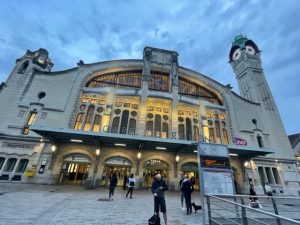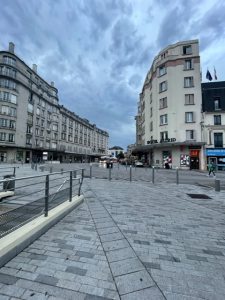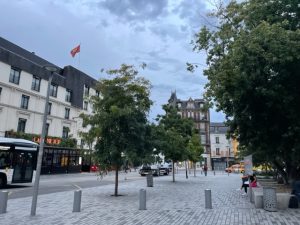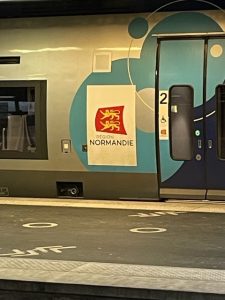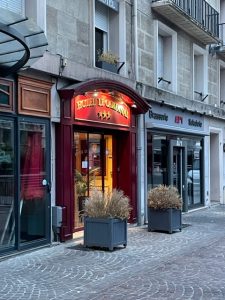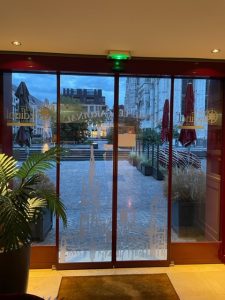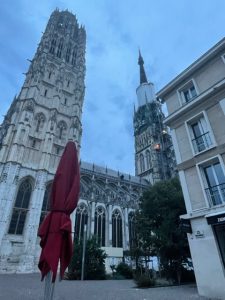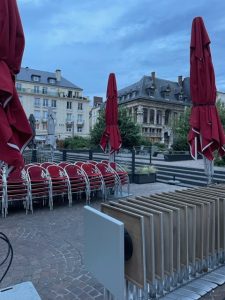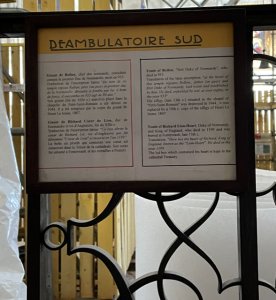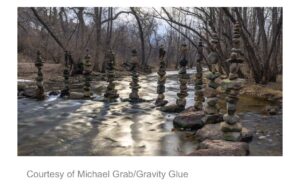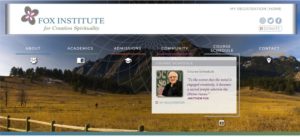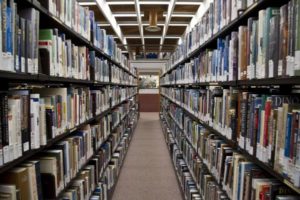Colorado
Dayle in Limoux – Day # 70
September 14, 2022Travel day full of trains and bus back two Limoux from Rouen.
First leg a little over five hours, to Marseilles. Much easier this time, maneuvering platforms and screens in the Marseilles terminal. Then, a three hour plus train ride to Carcassonne. It’s so interesting to me how I only have to say, “Bonjour,” and the first typical response is, ‘Oh, English.’ Almost feel like I should apologize. How do they know? Yes, I think it’s because my French pronunciation is really quite that bad. Not giving up. I so want to speak this beautiful language. I try. In the Rouen museum, I think I was pronouncing the painter Poussin, as ‘poisson,’ which is ‘fish’ in French. So the musée attendant was seemingly perplexed when I asked for directions to the Poussin exhibit and thought I said, “Where is the fish exhibit?” We finally figured it out together, both were laughing.
Leaving Hotel Cardinal early in the morning, the quiet of the cathedral square, the majesty of The Rouen Cathedral.
The cathedral a religious monument constructed in two phases with two distinct styles: starting in 1030 for its Roman-inspired section and in 1145 for its Gothic-inspired one. It was completed in 1506. It houses the remains of King Richard the Lionheart lie in the Cathedral.
I was asked if I was English (I guess so?) on the second train by a young man sitting next to me. He is from Ft. Collins, Colorado–my son’s age. One of my most favorite things traveling is meeting someone and talking with them as if we’ve known one another for a long while. His name is Hopper and we talked about everything from absolute truth, to ashrams in India, to the transgender movement–for three solid hours until the train stopped in Carcassonne. He wants to leave the United States, too. He’s going to work on a farm in France for a while, and then move to the Czech Republic, before finally landing in India. It was a lovely conversation. I haven’t spoken that much English in a long while.
I met with two women this morning, one who had been living in Portugal, now in Limoux and originally from Boston. The other women I had met earlier after I arrived. Learning so much about life in Limoux, their experiences, and future plans. La crème à café on the Place de la Republique. The best. l o v e
À bientôt.
🚉
Covid’s Delta
June 23, 2021The New Yorker
The Delta Variant Is a Grave Danger to the Unvaccinated
One half of America is protected. The other is approaching a perilous moment in the pandemic.
by Dhruv Khullar, a contributing writer at The New Yorker, is a practicing physician and an assistant professor at Weill Cornell Medical College.
Experts believe that the Delta variant is 60% more transmissible than Alpha, or the UK variant.
The variant now represents more than 20% of coronavirus infections in the U.S. in the last two weeks, or double what it was when the CDC last reported on the variant’s prevalence. [USA Today]
“The good news is that we have vaccines that can squash the Delta variant,” Eric Topol, the director of the Scripps Research Translational Institute, told me. “The bad news is that not nearly enough people have been vaccinated. A substantial share of Americans are sitting ducks.” He went on, “We haven’t built a strong enough vaccination wall yet. We need a Delta wall”—a level of vaccination that will prevent the new variant from spreading. “There are still large unvaccinated pockets in the country where this could get ugly,” Topol added. Because about half of Americans are vaccinated, and millions more have some immunity from prior infection, the Delta variant “won’t cause monster spikes that overwhelm the health system,” Topol said. But Delta spreads so easily among the unvaccinated that some communities could experience meaningful increases in death and disease this summer and fall.
In a recent piece, I likened a society that’s reopening while partially vaccinated to a ship approaching an iceberg. The ship is the return to normal life and the viral exposure that it brings; the iceberg is the population of unvaccinated people. Precautions such as social distancing can slow the speed of the ship, and vaccination can shrink the size of the iceberg. But, in any reopening society that’s failed to vaccinate everyone, a collision between the virus and the vulnerable is inevitable.
Because of its exceptional transmissibility, the Delta variant is almost certain to intensify the force of the collision. The U.K., by postponing a full reopening, is trying to soften the blow. But the U.S. is pressing ahead—perhaps out of hubris, or because officials hope that our vaccination campaign can outrun the spread of Delta. Last week, New York and California, among the pandemic’s hardest-hit states, did away with virtually all restrictions. Meanwhile, states with half the vaccination rates of New York or California have been open for weeks. A lot depends on where, and how fast, Delta is spreading.
AXIOS:
The rapid spread of the B.1.617 (Delta) variant first discovered in India is making the second dose “more important now than ever before,” state epidemiologist Rachel Herlihy said Monday.
- Colorado has the second-highest proportion of the variant in the nation and the fifth-highest overall positivity rate.
The Guardian:
‘Two Americas’ may emerge as Delta variant spreads and vaccination rates drop
Biden’s 70% vaccination target by Fourth of July likely to fall short as efforts to entice people to get shots have lost their initial impact
“I certainly don’t see things getting any better if we don’t increase our vaccination rate,” Scott Allen of the county health unit in Webster, Missouri, told Politico. The state has seen daily infections and hospitalizations to nearly double over the last two weeks.
Only 52% of Republicans said they were partially or fully vaccinated, and 29% said they have no intention of getting a vaccine, according to a CBS News/YouGov poll. 77% of Democrats said they were already vaccinated, with just 5% responding that were resisting the vaccine.
“I call it two Covid nations,” Peter Hotez, a vaccine researcher at Baylor College of Medicine in Houston, told BuzzFeed News.
Bette Korber, a computational biologist at the Los Alamos National Laboratory in New Mexico, said she expected variant Delta to become the most common variant in the US within weeks. “It’s really moving quickly,” Korber told Buzzfeed.
Boulder.
March 30, 2021‘An artist created a memorial in Boulder Creek to the victims of the King Soopers shooting.’
♥
Boulder, Colorado.
[AXIOS]
Boulder.
March 23, 2021We are wounded and wounding. Boulder is a tender, special community. Hands will reach and hearts will connect. So sorry. Grace. -dayle
Neven Stanisic, 23
Rikki Olds, 25
Tralona Bartkowiak, 49
Suzanne Fountain, 59
Teri Leiker, 51
Eric Talley, 51
Kevin Mahoney, 61
Lynn Murray, 62
Jody Waters, 65
#BoulderColorado
#EndGunViolence
#GunReformNow
#ForThePeopleAct
From Naropa University
“The hearts of Naropa University go out to the victims of the local shooting in Boulder, CO. Naropa will continue to offer support to our students and staff in the wake of this collective trauma.”
-
Dear Naropa Community,
Our hearts go out to the victims of the local shooting in Boulder this afternoon. While we do know that there were multiple fatalities, including one police officer, many details remain unknown as local, state, and federal officials are currently conducting their investigation. As the events unfolded, Naropa University enacted a coordinated communication effort, including emails to the campus community, text messages, website updates, and social media posts.
Even before the specifics are shared by the City of Boulder, what is clear is that the Boulder community has experienced a collective trauma which will require access to counseling services, peer to peer support and taking the time to care for ourselves and each other with compassion.
We will maintain our class schedule tomorrow so that students have opportunities to share in smaller groups with classmates. Our trusted faculty will certainly be very mindful of the pain and poignancy of the day and provide space to process the range of thoughts, feelings and emotions that will continue to arise. We will offer whatever flexibility is needed by any individual who need to process in ways other than classroom attendance.
We have reached out to our residential community and will continue to offer support to our students through our counselors and advisors. Please feel free to utilize our Students of Concern email address (studentconcerns@naropa.edu ) if you encounter a student who could use some additional outreach and support. Counseling Services is available to meet with students remotely by contacting their office at 303-245-4630 or email at studentcounselingcen@naropa.edu . Virtual drop-in hours will be available from noon-3:00 p.m.
We are also working to offer opportunities for staff, faculty and students to connect with support. Right now, Joy Redstone has offered to facilitate a time for staff to gather by zoom from 10:30 am to noon tomorrow. The link is https://naropa.zoom.us/j/5549680256.
Judy Lief will offer a drop-in time for anyone in the community from 9:30 to 10:30 am. The link is https://us02web.zoom.us/j/3663361210 and the passcode is 3yanas .
I and any available Cabinet members will also facilitate a Zoom gathering from 1-2 pm for anyone who wishes to join in community. That link is https://naropa.zoom.us/j/99564296531 .
We are receiving other offerings which will be announced as they are confirmed.
I greatly appreciate the very prompt and caring way in which staff and faculty related with this tragedy. These efforts are for the benefit of us all. At the same time, I know that it is a natural tendency in the face of trauma to fill the space with activities that are for the benefit of others, but can unintentionally repress the direct experience of our own thoughts and feelings. I hope that we will all take the time for personal healing, which is so important.
Please take care and don’t hesitate to seek support from our community.
With Gratitude to you all,
Chuck Lief
President
The Guardian
‘We don’t live in a safe world’: Boulder in shock and disbelief over shooting
A mourner visits the King Sooper’s grocery store where a deadly shooting occurred in Boulder, Colorado, on 23 March. Photograph: Chet Strange/Getty Images
Following the shooting in a Boulder, Colorado, grocery store on Monday, leaving 10 dead including a police officer, the community of this liberal mountain town are in a state of shock and disbelief, experiencing the all-too-common identity crisis experienced by so many American cities in the wake of a mass shooting.
“I’ve called this community home for most of my life, and I’ve shopped at that King Soopers many times,” Colorado’s governor, Jared Polis, said on Tuesday morning during a press conference.
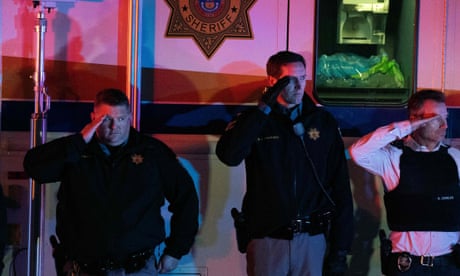
“Boulder is a small community, and we’re all looking at the list wondering if we know people. These were folks who started their day with a morning paper, cup of coffee, perhaps getting their kids ready, maybe making last-minute spring break plans, none of them expected that this would be their last day here, on the planet. A simple run for milk and eggs led to a complete tragedy.”
A 2019 analysis by the Denver Post found that, per capita, Colorado has more mass shootings than all but four states. But despite a recent anti-mask riot by college students, Boulder was considered by many as a safe oasis for middle- and upper-class liberals.
“Many of the shootings across the country have been in places people would like to think are safe, but when these tragedies hit close to home it threatens your feeling of safety,” said Jamie Beachy, directory of the Center for Contemplative Chaplaincy at Naropa University, in Boulder. “For some people, this will be very destabilizing for some time to come. We don’t live in a safe world when it comes to gun violence, and Boulder is not set apart from that.”
History is contingent.
November 12, 2019Matthew Fox, a 76-year-old elder, activist and spiritual theologian, along with Skylar Wilson, a 33-year-old wilderness guide, leader of inter-cultural ceremonies, and an event producer, and Jennifer Berit Listug, a 28-year-old writer, spiritual leader, and publicist, are presenting a challenge and an opportunity in the vision launched in this modest book. That vision is about creating an Order of the Sacred Earth. Essay contributors to the book and its vision include Mirabai Starr, Brian Thomas Swimme, Adam Bucko, and David Korten.
‘In this book the author and contributors present opportunity for building an intergeneration community devoted to environmental activism through restoring a sense of the sacred.
Order of the Sacred Earth is for everyone from all faiths and religions, races, lifestyle choices, generations, professions and ancestry. All are welcome…all are needed…to build a conscious of the whole in service to the Earth and to one another.
1976: Institute for Creation Spirituality, Boulder Colorado
Fox invites us to listen to our deep calling by asking:
What can most readily stir us at his time in history to wake up, let go, give birth and work generously and diligently for the survival of our species and of our planet? What links the wisdom of the young to the wisdom of the old and of our ancestors, while opening our heart and mind to serve future generations with joy and resolve?
What most empowers us to move from inertia to effective caring and action, from despair or cynicism to hope-filled service?’
-Science of Mind
Public Funded Journalism
August 13, 2019As News Deserts Encroach, One City Looks At A New Way To Fund Local Journalism
By Rae Ellen Bichell
Originally published on August 5, 2019 5:15 pm
Boise State Public Radio
Many parts of the Mountain West are news deserts — and it’s getting worse. More than 20 counties in our region have no local newspaper. The ones that are left are struggling. And research suggests news deserts contribute to low voter turnoutand increasing partisanship.
Scott Converse could feel the desert closing in on his community. His local newspaper in Longmont, Colorado had just announced it was closing its offices and moving to Boulder.
“All of Longmont’s news left Longmont, effectively,” says Converse. “Honestly, it just P.O.’d me.”
So, he took action. He and another Longmont resident started their own publication — the Longmont Observer. From the get-go, though, funding was a problem. It’s run by a small team of reporters and editors, all of them volunteers. Converse jokes their editor-in-chief is doing really well.
“She has gotten at least a dozen raises from zero, to two times zero, to four times zero to eight times zero,” he says. “We’re proof that news is not profitable. We get enough donations to pay our rent and our Internet here and that’s it. That’s literally it.”
“That’s how dictators get started,” reads a quote warning of the perils of a quashed press. It’s one of many flanking the Longmont Observer office where Scott Converse works.
So lately, Converse has been looking for new ideas for how to fund local journalism. That’s when he came across an article called, “Journalism is a public service. Why don’t we fund it like one?”
Simon Galperin wrote the piece. He’s the founding director of a nonprofit called the Community Information Cooperative, based in New Jersey.
“People feel it in a visceral way when they don’t have the sort of information they need to get about their day,” says Galperin. He says we need a way to publicly fund news that’s independent from the local government, and he says the way to do this is through a common technique — starting something called a special improvement district. These already exist in communities across the country for a bunch of purposes: parks, sewers, airports, highways.
“Fire safety, mosquito abatement,” Galperin adds. “So, it kind of just made sense to say, ‘Okay, let’s create one for local news and information.’”
Technically, special districts are their own independent government units. They have their own funding, separate from the city budget, and their own governing board.
“The info district idea is an opportunity for people to do this themselves without relying on benevolent billionaires or wealth to come in and prop up a news organization,” he says. “This is a way for the public to have a say in how their local news and information needs are met.”
Galperin, who just published a how-to guide on starting a special district, says funding through a special district might allow a community to spread information in a bunch of different ways, including by hiring journalists — maybe even full newsrooms. Back in Longmont, that idea was a light bulb moment for Scott Converse.
“I thought, ‘That’s brilliant. What a great idea,’” he says.
He learned that there’s a type of special district that’s actually really common in Colorado. They’re for libraries. And what are libraries, he says, if not non-partisan, non-profit sources of trusted information chock full of some of the nation’s best information ninjas?
“Librarians are badasses. You do not mess with the librarian. If you try to remove a book from a library, you almost have to kill a librarian. It’s not easy. And that’s because they believe in the freedom of information,” says Converse. “They have more legal protections than just about any other entity on the planet for protecting information.”
They’re also non-partisan, nonprofit and community-driven, he adds. “What better place to put a newsroom?”
Converse dreams of the library housing not just a staff of local journalists, but also tools for citizen journalists to cover their community, like a makerspace for news.
“Never shushed anyone in a library in my life, don’t plan to start,” says Longmont Library director Nancy Kerr, as she walks through the lobby on a weekday morning. The library is gently bustling with residents looking through books on display and kids picking up prizes for summer reading.
“You expect libraries now [to] have at least a low hum of conversation going on. It’s not your parents’ or grandparents’ library,” she says.
The city is doing a feasibility study right now about how to better fund the Longmont library, including the possibility of starting a special district. Kerr says they’re asking stakeholders “a sea of questions” about the future of the library, and its role in creating local news content is among them.
“We really believe in people’s rights to read anything and everything and support that,” she says, so she was intrigued to hear the idea Scott Converse had hit on.
Libraries, Kerr says, are changing. If you haven’t been to one in a while, take a look. You might be surprised. This library has an old card catalogue full of seeds for people to plant in their gardens. Kerr says librarians help people with resumes and job applications all the time. And they just started a library of things, where people can check out everything from ukeles and telescopes to wifi hotspots.
“We’re always looking at new opportunities to connect people with information.” she says. “There have been some arguments out there that libraries are not content creators, but more and more libraries are content creators.”
In the most literal sense of content creation, a growing number of libraries host equipment for physically producing new material, like 3-D printers and machineryfor self-publishing actual books. In a broader sense, Kerr adds, they’re already starting to share more characteristics with news organizations — like the libraries that have podcasting equipment and green screens available, or even the ones with plans to house a public TV channel in the same building.
“Nothing is an impossibility for libraries,” says Kerr. “I can’t see immediately that libraries would necessarily be able to do this on their own and be the producer — the creator — of the news. But as far as disseminating news from a library, I don’t see that as a strange thing. That’s what we do.”
Scott Converse says he’s getting some pushback on the idea of a government funded news service. But he’s got an answer for that.
“It’s not government-run news. It’s news run by the people, for the people and funded by the people,” he says, just like the BBC in the U.K., CBC in Canada or, at least in part, public radio here.
Still, there are skeptics. Sure, a library could spread information about local events and such, but what would it mean for library-affiliated journalists to take on local investigations? That’s one of the questions Melissa Milios Davis is mulling.
“I think there’s a lot of people who wonder if that would erode the trust of the library for them to be in that role,” says Davis, who is a Longmont resident, a former journalist and who works for a Colorado organization called the Gates Family Foundation (different from the Bill & Melinda Gates Foundation). “I think that’s a real, valid concern.”
As a member of the executive committee of a group called the Colorado Media Project, she’s leading a public policy study due out in the fall on what role public funding could play in sustaining local public-interest journalism.
“We’re looking at: What is the role of philanthropy? What’s the role of individuals? And what’s the role — potentially — of local governments in supporting the information needs of communities?” she says. “I think the conundrum right now as we’re looking for different revenue sources is to really figure out where are those bright lines between what government sources could be good and better used for, in terms of informing communities, and then other things that are really the realm of independent journalism.”
The Longmont Times-Call has run a number of articles and opinion pieces criticizing the idea that the library could play a role in disseminating local news, likening it to “a government-owned press,” “a tool of dictatorships” and quoting people on issues of trust and the importance of transparent funding.
Ironically, that paper is one of many that are backed by a New York-based hedge fund, Alden Global Capital, which is not only opaque about its investors but has also shown itself to be hostile to local news.
“We’re just naturally a cynical nation about big government — about government of any kind,” says Julie Reynolds, a freelance journalist who’s investigating Alden Global Capital. But, she says, “I don’t think people understand very much about where their news comes from or how it gets produced or how it gets funded.”
The hedge fund backs the MediaNews Group, previously known as Digital First Media. According to its website, it currently owns about 100 local publications, 19 of them in Colorado, including the Longmont Times-Call and the Denver Post. Reynolds says it took her 3 years to trace what funds the newspapers were held under.
“Like most hedge funds, Alden Global Capital is a labyrinth of real estate, LLCs, small corporations, other funds, most of them based in tax secrecy havens in the Cayman Islands, where they pay lower taxes and there’s also almost no disclosure,” Reynolds says. “So, you don’t know who owns or controls those funds. We don’t actually know who ultimately is invested in them. Are there overseas actors involved in our media? We don’t really know.”
As she writes in Newsweek, Reynolds used to work at a California paper that was “stripped for parts” by Alden Global Capital. (Court records show the hedge fund used profit from such publications to buy unrelated businesses, like a pharmacy chain called Fred’s).
Reynolds recently started a new online publication to revegetate her county’s news desert. It runs on philanthropy and reader contributions to stay afloat. She says the special district idea that Longmont is looking into stands out.
“I can see some issues and concerns, but there’s always issues and concerns about the independence of the media,” says Reynolds. “I think it’s a fascinating idea.”
This story was produced by the Mountain West News Bureau, a collaboration between Wyoming Public Media, Boise State Public Radio in Idaho, KUER in Salt Lake City, KUNR in Nevada and KRCC and KUNC in Colorado.
This is how we roll…grassroots.
September 2, 2016NPR/September 2, 2016
‘There’s a new push in the national conversation about gun violence that is attempting to sidestep the political rancor, to find common ground on one thing — guns and suicide. The campaign in Colorado is called the Colorado Gun Shop Project.
The ‘poster reads, Gun Owners Can Help! Under a photo of a lone elk in the mountains, it lists signs someone may be suicidal and a phone number for the National Suicide Prevention Lifeline.
There’s now an 11th commandment on gun safety rules: Consider off-site storage — family, friends, some shooting clubs, police departments or gun shops — if a family member may be suicidal. Clark says most people don’t realize that the majority of gun deaths are not homicides but suicide.
A survey of hospital emergency rooms by the Centers for Disease Control and Prevention in 2011 found an estimated 21,175 suicides involving firearms compared with 11,208 homicides involving guns.’
Full article:
MARCH 30TH, 2017 UPDATE BY JOHN HAWTHORNE:
